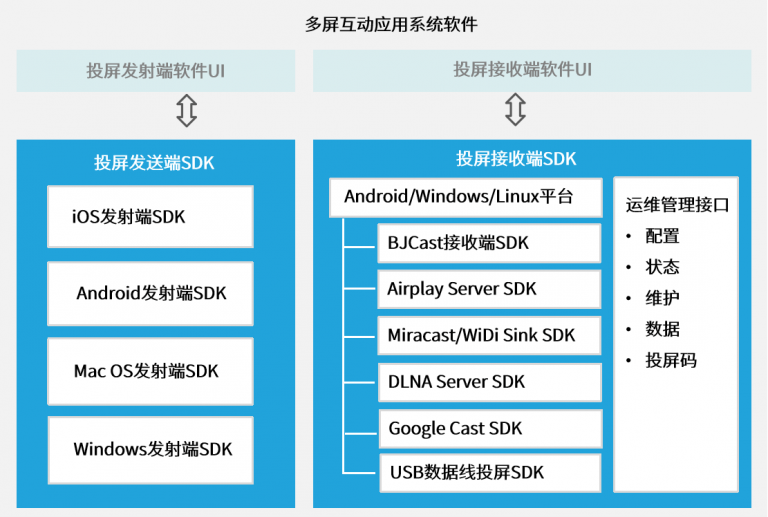Projection SDK – Bijie SDK Integration Solution, Empowering Enterprises
The Bijie Wireless Screen Projection SDK is a complete set of wireless display and multi screen interactive application development kits, including the transmitter SDK and receiver SDK, compatible with AirPlay Miracast, WiDi, GoogleCast, DLNA, BJCast (self-developed) projection protocols, compatible with iOS Android, Windows, Mac OS, and Linux system devices provide customizable development interfaces and comprehensive technical documentation and demos, making it convenient for third-party partners to call and integrate.
Bijie Screen Projection SDK
Launching SDK: Supports Android Intelligent devices for iOS, Windows, and Mac systems, supporting wireless screen mirroring on a local area network. Users can integrate the transmitter SDK into their own apps or software applications, and use it with the Bijie screen mirroring receiver device to achieve mobile phone Pad, PC wireless image projection.
Receiver SDK: Supports Android Windows and Linux operating systems, fully compatible with HiSilicon Amlogic、 Ruixin Micro Sigmastar、 Quanzhi, Intel and other chip platforms, compatible with Airplay Miracast, WiDi, GoogleCast, DLNA, BJcast (self-developed by Bijie) wireless screen projection protocols, as well as USB data cable wired screen projection, facilitate integration among chip manufacturers, set-top box manufacturers, TV manufacturers, and device integrators.
Design diagram of transmitter SDK and receiver SDK

SDK applicable scenarios:
1. Enterprise intelligent office integration
Integrating the transmitter SDK into smart office devices, through wireless screen projection and multi screen interaction, enables better intelligent office work and improves the efficiency of individual or group office affairs.
2. Integration of smart education equipment
Integrating the launch end SDK into smart education devices through central control, realizing functions such as smart podiums and group interactions, utilizing intelligent technology to build an intelligent teaching environment, optimizing the presentation of teaching content, promoting classroom interaction, etc., improving the quality and efficiency of classroom teaching, and truly realizing the deep integration of information technology and educational teaching.
3. Intelligent hardware integration
- Intelligent projector
Integrating the SDK into a smart projector allows for wireless projection of conference content, reducing the complexity of programs and making it more convenient to use.
- Project glass
Integrating the SDK into smart glasses can project games from VR glasses onto the TV for a wider user experience. Or project games from computers or mobile phones onto VR glasses to give users an immersive feeling.
- Vehicle navigation
Integrating the SDK into car navigation allows for direct projection onto the infotainment system when navigation is needed. The infotainment system has a larger screen and clearer map display, making it easier for drivers to view navigation information while driving. Some infotainment systems can also be projected onto the instrument panel, so drivers do not need to shift their gaze to the central control screen. They only need to look at the instrument panel, making driving safer.
- Display large screen
Integrate the SDK into the display screen, supporting 1080p high-definition display, wireless screen mirroring on mobile phones and computers, seamless screen mirroring, and switching between large and small screens as needed; Apps such as iQiyi, Youku, and Tencent Video directly project videos, making it simple and easy to use.
- Smart Home
Integrating SDK into smart homes allows people to optimize their lifestyle and living environment by projecting recipes onto a range hood with a small screen, food preservation temperature onto a refrigerator with a screen, and skincare steps onto a mirror with a screen projection function. This helps people effectively manage time and save various energy.